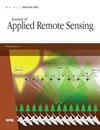Lineament mapping in the Edea area (Littoral, Cameroon) using remote sensing and gravimetric data: hydrogeological implications
IF 1.4
4区 地球科学
Q4 ENVIRONMENTAL SCIENCES
引用次数: 0
Abstract
The aim of this study is to map and analyze the lineament network in the Edéa, Cameroon, area using remote sensing and gravimetric data to determine their hydrogeological implications. Principal component analysis and directional filters applied to Landsat7 ETM+ and Shuttle Radar Topography Mission imagery, respectively, were used to extract remote sensing lineaments. Rose diagram of these lineaments highlights four families of lineaments along the N–S, E–W, NE–SW, and NW–SE directions. There are three major directions accounting for 74% of lineaments, including N0° to N10°, N20° to N30°, and N40° to N50°; and four minor directions (with 26% of the lineaments), including N60° N70°, N80° to N90°, N130° to N140°, and N150° to N160°. N20° to N90° directions correlate with those of major structures of the Oubanguides Complex, such as the Sanaga Fault and Central Cameroon Shear Zone. N130° to N140° direction corresponds to orientation of Shear Zones and blastomylonitic faults of Nyong Complex. Superposition of these lineaments on hydrographic network shows similarities between their directions, thus highlighting strong impact of tectonics on orientation of hydrographic network. The presence of numerous lineaments highlights strongly fractured subsoil, and their high density favors the circulation and accumulation of groundwater. Upward continuation and horizontal gradient maxima methods applied to Earth Gravitational Model 2008 data allowed the extraction of gravimetric lineaments, with a major N–S orientation, which correlates with general orientation of South Atlantic opening. Superposition of remote sensing lineaments and gravimetric lineaments highlights their parallelism, admitting that gravimetric structures are an extension in depth of surface structures defined by remote sensing.利用遥感和重力测量数据绘制埃代阿地区(喀麦隆滨海)的地线图:水文地质影响
本研究旨在利用遥感和重力测量数据绘制和分析喀麦隆埃代阿地区的线状网络,以确定其水文地质影响。对 Landsat7 ETM+ 和航天飞机雷达地形图任务图像分别采用主成分分析和方向滤波器来提取遥感线状体。这些线状体的玫瑰图突出显示了沿 N-S、E-W、NE-SW 和 NW-SE 方向的四个线状体系列。其中,N0°至 N10°、N20°至 N30°、N40°至 N50°为三个主要方向,占 74%;N60°至 N70°、N80°至 N90°、N130°至 N140°、N150°至 N160°为四个次要方向,占 26%。N20° 至 N90° 走向与乌班吉德斯复合体的主要构造(如萨纳加断层和喀麦隆中部剪切带)相关。N130° 至 N140° 方向与尼永岩群的剪切带和隆起断层的走向一致。这些线状构造在水文地理网络上的叠加显示了其方向的相似性,从而突出了构造对水文地理网络方向的强烈影响。大量线状构造的存在凸显了强烈断裂的底土,其高密度有利于地下水的循环和积聚。将向上延续和水平梯度最大值方法应用于 2008 年地球重力模型数据,可以提取出重力线状体,其主要方向为南北向,与南大西洋开口的总体方向相关。遥感线状结构和重力测量线状结构的叠加凸显了它们之间的平行关系,承认重力测量结构是遥感确定的地表结构在深度上的延伸。
本文章由计算机程序翻译,如有差异,请以英文原文为准。
求助全文
约1分钟内获得全文
求助全文
来源期刊

Journal of Applied Remote Sensing
环境科学-成像科学与照相技术
CiteScore
3.40
自引率
11.80%
发文量
194
审稿时长
3 months
期刊介绍:
The Journal of Applied Remote Sensing is a peer-reviewed journal that optimizes the communication of concepts, information, and progress among the remote sensing community.
 求助内容:
求助内容: 应助结果提醒方式:
应助结果提醒方式:


